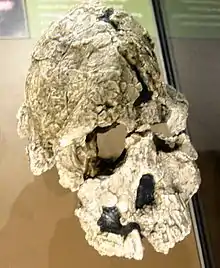Kenyanthropus platyops
Kenyanthropus platyops is an extinct hominid species discovered in Lake Turkana, Kenya in 1999. It was by Justus Erus, who was part of Meave Leakey's team.[1]
| Kenyanthropus platyops Temporal range: Pliocene | |
|---|---|
| Scientific classification | |
| Kingdom: | |
| Phylum: | |
| Class: | |
| Order: | |
| Family: | |
| Subfamily: | |
| Genus: | Kenyanthropus |
| Binomial name | |
| †Kenyanthropus platyops Leakey et al., 2001 | |

The fossil is 3.5 to 3.2 million years old. It has a broad flat face with a toe bone that suggests it probably walked upright. Teeth are intermediate between typical human and typical ape forms.
Leakey proposed that the fossil represents an entirely new hominine genus.[2] Others classify it as a separate species of Australopithecus, Australopithecus platyops, and still others interpret it as an individual of Australopithecus afarensis.
If some palaeoanthropologists are correct, Kenyanthropus may not even represent a valid taxon. The specimen is so distorted by matrix-filled cracks that meaningful morphological characteristics are next to impossible to assess with confidence.
References
- Kenyanthropus platyops
- Leakey, Meave G.; Spoor, Fred; Brown, Frank H.; Gathogo, Patrick N.; Kiarie, Christopher; Leakey, Louise N.; McDougall, Ian (2001). "New hominin genus from eastern Africa shows diverse middle Pliocene lineages". Nature. 410 (6827): 433–440. Bibcode:2001Natur.410..433L. doi:10.1038/35068500. PMID 11260704. S2CID 4409453.